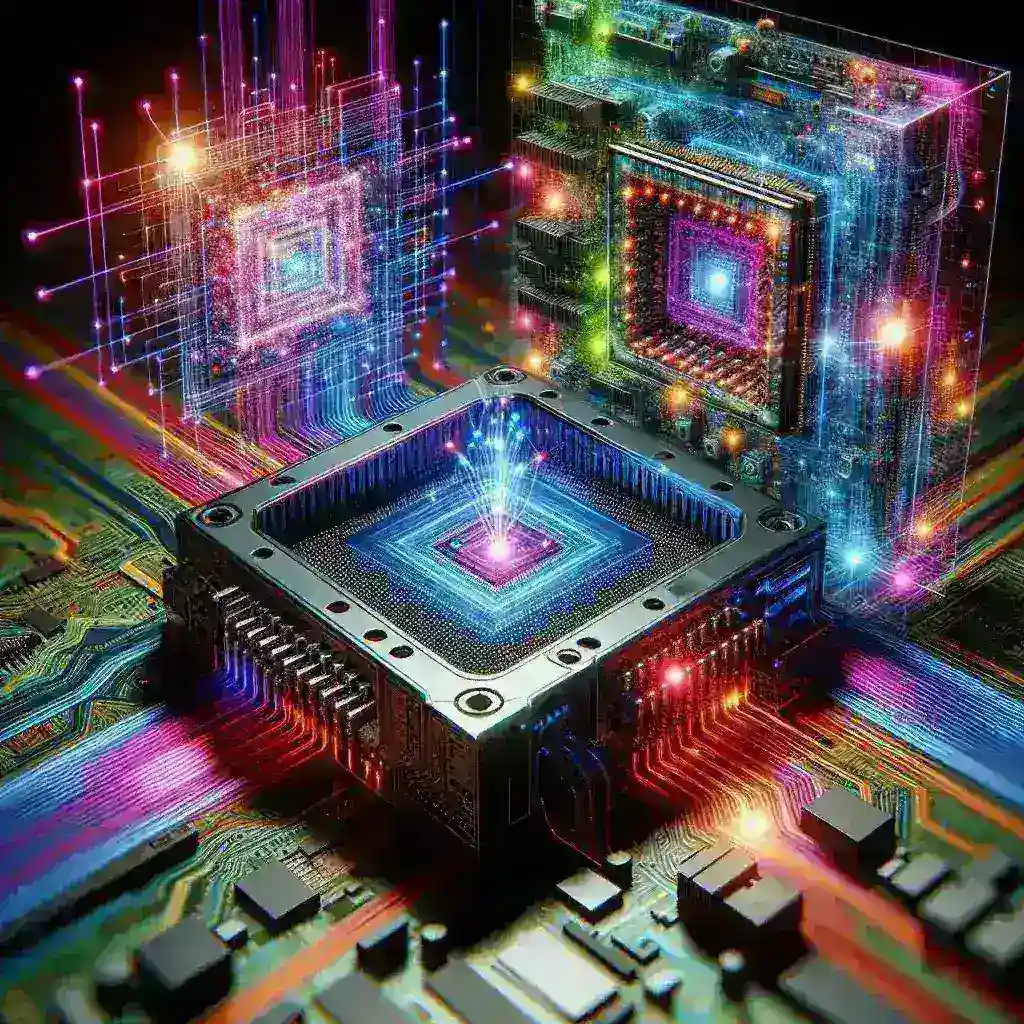The Evolution of AI Inference Hardware: Introducing the GB300 in DGX B300 Systems
The landscape of artificial intelligence has been rapidly evolving, with computational demands growing exponentially as models become increasingly complex. At the forefront of this evolution stands NVIDIA’s latest technological marvel – the GB300 Blackwell GPU, now integrated into their powerful DGX B300 systems. This integration represents a significant milestone in AI inference capabilities, promising to redefine what’s possible in enterprise AI deployment.
The marriage between the GB300 architecture and DGX B300 systems creates a powerhouse specifically designed to handle the most demanding inference workloads with unprecedented efficiency and speed. As organizations worldwide race to implement AI solutions at scale, understanding this technological advancement becomes crucial for IT decision-makers, data scientists, and business leaders alike.
Understanding the GB300 Blackwell Architecture
The GB300 GPU represents NVIDIA’s most advanced Blackwell architecture, succeeding the previous Hopper generation with substantial improvements across all performance metrics. Before diving into its integration with DGX B300 systems, let’s examine what makes this GPU so revolutionary for AI inference tasks.
Technical Specifications and Capabilities
The GB300 boasts impressive specifications that set new standards in the industry:
- Transistor Count: With billions of transistors packed into its die, the GB300 offers computational density previously unimaginable.
- Memory Bandwidth: Featuring HBM3e memory, the GB300 provides exceptional bandwidth crucial for handling large AI models.
- FP8 and INT8 Performance: Specifically optimized for inference workloads with enhanced performance for these precision formats commonly used in deployed AI models.
- Transformer Engine: Purpose-built for accelerating transformer-based models that dominate modern AI applications.
- Energy Efficiency: Significant improvements in performance-per-watt metrics, addressing a critical concern in data center deployments.
The architecture incorporates specialized tensor cores designed explicitly for inference acceleration, with optimizations for the most common operations in deployed AI models. This hardware-level specialization translates directly to performance gains when handling real-world inference tasks.
Advancements Over Previous Generations
Compared to its predecessor, the H100 Hopper architecture, the GB300 delivers substantial improvements:
- Up to 4x faster inference performance on large language models
- Approximately 25% reduction in power consumption for equivalent workloads
- Enhanced support for sparsity and quantization techniques that accelerate inference
- Improved multi-tenant capabilities for serving multiple models simultaneously
These advancements didn’t materialize overnight – they represent the culmination of NVIDIA’s decades-long investment in GPU architecture and AI acceleration. The Blackwell architecture builds upon lessons learned from previous generations while introducing novel approaches to inference-specific challenges.
The DGX B300 System: Purpose-Built for Enterprise AI
While the GB300 GPU itself is impressive, its true potential is unlocked when integrated into NVIDIA’s DGX B300 system – a purpose-built AI computing platform designed to tackle enterprise-scale inference workloads.
System Architecture and Components
The DGX B300 represents a holistic approach to AI infrastructure with careful consideration given to every component:
- GB300 GPU Configuration: Each DGX B300 incorporates multiple GB300 GPUs in an optimized arrangement for maximum throughput.
- NVLink Interconnect: The proprietary high-bandwidth, low-latency connections between GPUs eliminate bottlenecks when handling distributed inference tasks.
- CPU Subsystem: Powerful server-grade CPUs handle preprocessing, orchestration, and system management.
- Networking: Integrated high-speed networking components enable seamless scaling across multiple DGX units.
- Storage Subsystem: Optimized for the high-throughput requirements of AI inference workloads.
- Cooling Infrastructure: Advanced thermal management systems ensure optimal performance under sustained loads.
The system architecture follows a balanced design philosophy, ensuring that no single component becomes a bottleneck during inference operations. This allows organizations to maximize their return on investment by fully utilizing the GB300’s capabilities.
Software Ecosystem and Optimization
Hardware alone isn’t sufficient for inference excellence – the DGX B300 comes with a comprehensive software stack specifically tuned for inference workloads:
- NVIDIA AI Enterprise: A software suite optimized for running AI workloads in enterprise environments.
- TensorRT: NVIDIA’s inference optimizer and runtime that maximizes throughput on GB300 hardware.
- NVIDIA Triton Inference Server: A deployment platform that simplifies serving models across multiple GB300 GPUs.
- Performance Libraries: Optimized implementations of common inference operations that take full advantage of GB300 architecture.
This software ecosystem represents years of development and optimization, providing a mature foundation that allows organizations to deploy inference workloads with minimal friction. The tight integration between hardware and software creates a multiplier effect on performance that exceeds what either could achieve independently.
GB300 Integration: Engineering Challenges and Solutions
Integrating the powerful GB300 GPUs into the DGX B300 system presented numerous engineering challenges that NVIDIA had to overcome through innovative solutions.
Thermal Management and Power Delivery
The GB300’s computational density generates significant thermal output that must be efficiently managed:
- Advanced Cooling Solutions: The DGX B300 employs multi-stage cooling systems combining air and liquid cooling technologies.
- Power Delivery: Sophisticated power management systems ensure stable delivery even under peak loads.
- Dynamic Thermal Throttling: Intelligent systems adjust performance parameters to maintain optimal operating conditions.
These thermal management innovations allow the GB300 to sustain peak performance during extended inference sessions without degradation due to thermal constraints – a critical consideration for production environments.
System Interconnect Optimization
Inference workloads often require communication between multiple GPUs, making the interconnect architecture crucial:
- NVLink 5th Generation: The latest iteration of NVIDIA’s GPU interconnect technology provides unprecedented bandwidth between GB300 units.
- Topology Optimization: The physical arrangement of GPUs minimizes communication distances and maximizes throughput.
- Memory Coherence: Advanced protocols maintain data consistency across distributed inference tasks.
These interconnect optimizations ensure that multi-GPU inference workloads scale efficiently, allowing organizations to tackle even the largest models with confidence.
Real-World Performance: GB300 in DGX B300 for Inference Tasks
Beyond technical specifications, what truly matters is how the GB300-equipped DGX B300 systems perform on real-world inference workloads. The results are nothing short of revolutionary across multiple AI application domains.
Large Language Model Inference
Large Language Models (LLMs) represent one of the most challenging inference workloads due to their size and computational requirements:
- Throughput Improvements: A single DGX B300 can process up to 4x more inference requests per second compared to previous-generation systems.
- Latency Reduction: Response times for LLM queries have been reduced by up to 60%, enhancing interactive applications.
- Context Length Handling: The GB300’s architecture efficiently manages the extended context lengths modern LLMs require.
These performance gains translate directly to improved user experiences in applications like conversational AI, content generation, and document analysis – all while reducing infrastructure costs per inference.
Computer Vision and Image Processing
Vision models benefit significantly from the GB300’s architecture:
- Batch Processing: The ability to process thousands of images simultaneously enables real-time analysis of video streams.
- Resolution Scaling: High-resolution image processing sees particularly dramatic improvements.
- Multi-Model Pipelines: Complex vision workflows combining multiple models can now run with minimal latency.
Industries like manufacturing, retail, and security benefit immensely from these improvements, enabling applications that were previously impractical due to performance constraints.
Multimodal AI Applications
Perhaps most impressively, the GB300 in DGX B300 systems excels at multimodal inference – processing combinations of text, images, audio, and other data types:
- Cross-Modal Processing: The unified architecture efficiently handles diverse data types without performance penalties.
- Memory Management: The generous memory capacity accommodates large multimodal models without compromises.
- Scheduling Efficiency: Intelligent workload management optimizes resource allocation across heterogeneous tasks.
This multimodal capability enables next-generation applications that process and understand the world more holistically, mirroring human-like perception and reasoning.
Enterprise Deployment Considerations
For organizations considering the adoption of GB300-equipped DGX B300 systems for inference workloads, several practical considerations come into play.
Total Cost of Ownership Analysis
While the initial investment in DGX B300 systems is significant, a comprehensive TCO analysis reveals compelling economics:
- Infrastructure Consolidation: A single DGX B300 can replace multiple racks of previous-generation inference servers.
- Power Efficiency: Reduced energy consumption translates to substantial operational savings over the system lifetime.
- Management Simplification: Fewer physical units reduce administrative overhead and maintenance costs.
- Scaling Economics: The performance per dollar improves as inference workloads grow in complexity and volume.
Organizations typically find that despite higher upfront costs, the total cost of ownership over a 3-5 year period favors the GB300-based solution, especially as inference demands continue to increase.
Integration with Existing Infrastructure
The DGX B300 system with GB300 GPUs is designed for seamless integration into enterprise environments:
- Containerization Support: Full compatibility with Docker and Kubernetes enables consistent deployment across hybrid environments.
- API Compatibility: Existing inference applications can typically migrate with minimal code changes.
- Monitoring Integration: Support for standard monitoring tools allows incorporation into existing operational frameworks.
- Security Features: Enterprise-grade security capabilities protect sensitive inference workloads and data.
This integration flexibility reduces adoption barriers, allowing organizations to incorporate GB300 capabilities without disrupting established workflows.
Case Studies: GB300 in DGX B300 Transforming Industries
The impact of GB300 integration in DGX B300 systems is already being felt across multiple industries, with early adopters reporting transformative results.
Financial Services: Real-Time Risk Analysis
A leading global bank deployed DGX B300 systems with GB300 GPUs to revolutionize their risk analysis capabilities:
- Challenge: Processing complex risk models across vast portfolios within market-relevant timeframes.
- Solution: Deployment of GB300-equipped DGX B300 systems dedicated to inference workloads.
- Results: Risk calculations that previously required overnight batch processing now complete in minutes, enabling intraday risk adjustments and more responsive trading strategies.
This capability has transformed their competitive position, allowing more aggressive yet secure trading positions based on near-real-time risk insights.
Healthcare: Medical Imaging Diagnostics
A healthcare technology provider integrated GB300-powered inference into their diagnostic imaging platform:
- Challenge: Analyzing high-resolution medical images with multiple AI models while maintaining radiologist workflow efficiency.
- Solution: DGX B300 deployment processing images through an ensemble of specialized diagnostic models.
- Results: Diagnostic processing time reduced from minutes to seconds per image, with improved accuracy through the use of more sophisticated models previously too computationally expensive to deploy.
The performance improvements have not only increased throughput but enabled the deployment of more advanced diagnostic algorithms, improving patient outcomes through earlier and more accurate detection.
Retail: Personalization at Scale
A major e-commerce platform leveraged GB300 inference capabilities to transform their recommendation systems:
- Challenge: Providing truly personalized recommendations across millions of products and customers in real-time.
- Solution: GB300-based inference cluster processing complex graph neural networks and transformer-based recommendation models.
- Results: 32% increase in conversion rates through more contextually relevant recommendations, with the ability to incorporate real-time browsing behavior into suggestions.
The performance headroom provided by the GB300 has allowed them to continuously deploy increasingly sophisticated recommendation algorithms without infrastructure changes.
Future Directions: The Evolution of GB300 in DGX Ecosystems
The integration of GB300 into DGX B300 systems represents not an endpoint but a beginning. Several emerging trends will likely shape the continued evolution of this technology pairing.
Model Serving Architectures
The extraordinary inference capabilities of GB300-equipped systems are driving innovations in how models are served:
- Microservice Inference: Breaking complex models into specialized components that can be independently scaled and updated.
- Dynamic Model Loading: Intelligent systems that load models on demand based on usage patterns, maximizing GPU utilization.
- Inference-as-a-Service: Internal platforms allowing organizations to centralize inference capabilities across business units.
These architectural innovations help organizations extract maximum value from their GB300 investments by optimizing utilization across diverse workloads.
Edge-to-Core Inference Pipelines
While DGX B300 systems typically reside in data centers, the inference landscape increasingly spans from edge to core:
- Distributed Inference: Coordinated processing across edge devices and GB300-equipped data centers.
- Model Distillation: Using GB300 systems to train compressed models that can run efficiently on edge devices.
- Hybrid Processing: Intelligent partitioning of inference tasks between edge devices and centralized GB300 resources.
This distributed approach maximizes the impact of GB300 capabilities across the entire AI infrastructure ecosystem.
Best Practices for GB300 Inference Optimization
Organizations deploying GB300-equipped DGX B300 systems can maximize their return on investment by following established best practices for inference optimization.
Quantization and Model Optimization
The GB300 architecture offers exceptional support for reduced-precision inference:
- INT8 and FP8 Conversion: Most models can be converted to these formats with minimal accuracy loss while gaining substantial performance.
- Sparsity Exploitation: Techniques like pruning and sparse attention mechanisms are particularly effective on GB300 hardware.
- Operator Fusion: Combining multiple operations into optimized kernels reduces memory transfers and increases throughput.
These optimizations can often deliver 2-3x performance improvements beyond the base capabilities of the hardware.
Batch Size Optimization
Finding the optimal batch size is crucial for maximizing GB300 inference efficiency:
- Latency vs. Throughput: Larger batch sizes increase throughput at the cost of individual request latency.
- Dynamic Batching: Implementing intelligent batching strategies that adapt to current load conditions.
- Multi-Query Optimization: Special techniques for transformer models that process multiple sequences simultaneously.
Properly tuned batching strategies can often unlock 30-50% additional performance on inference workloads.
Workload Distribution and Scheduling
Effectively managing how inference tasks are distributed across GB300 GPUs is essential:
- Affinity-Based Scheduling: Assigning related inference tasks to the same GPU to maximize cache efficiency.
- Load Balancing: Ensuring even distribution of work across available GB300 units.
- Priority-Based Execution: Implementing QoS mechanisms for time-sensitive inference requests.
These scheduling optimizations ensure consistent performance and maximize hardware utilization under varying load conditions.
Conclusion: The Transformative Impact of GB300 in DGX B300 Systems
The integration of GB300 GPUs in DGX B300 systems represents a watershed moment in AI inference capabilities. This technological pairing delivers performance that was barely imaginable just a few years ago, enabling a new generation of AI applications characterized by their responsiveness, sophistication, and scale.
For organizations deploying AI at scale, the advantages are multifaceted:
- Performance Density: Unprecedented inference throughput per rack unit, transforming data center economics.
- Model Complexity: The ability to deploy increasingly sophisticated models that deliver higher accuracy and capability.
- Operational Efficiency: Reduced power consumption and management overhead through consolidation.
- Future-Proofing: Headroom to accommodate the continually growing demands of evolving AI workloads.
As AI continues its journey from experimental technology to business-critical infrastructure, the role of specialized inference hardware like the GB300 in DGX B300 systems will only grow in importance. Organizations that master this technology now are positioning themselves at the forefront of the AI revolution, with capabilities that will define competitive advantage in the coming decade.
The GB300’s integration in DGX B300 systems doesn’t merely represent an incremental improvement in inference capabilities – it fundamentally redefines what’s possible, opening new horizons for AI applications across every industry. As these systems proliferate through enterprise data centers, we can expect an acceleration in AI adoption and innovation that will transform how organizations operate and the experiences they deliver to customers.




